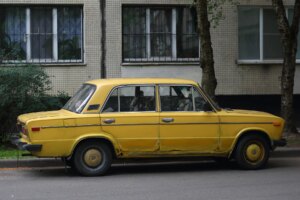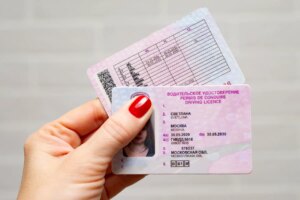Important notice from the Editor in Chief
Maintaining our Russian site is a delicate matter during the war. We have chosen to keep its content online to help our readers, but we cannot ensure that it is accurate and up to date. Our team endeavors to strike the right balance between giving information to those who need it, and respecting the gravity of the situation.
The road system and traffic rules in Russia aren’t dramatically different from European countries. But driving in the country can be a frustrating experience, with drivers having to contend with lengthy traffic jams, poor road maintenance, and random police inspections. It also has a poor road safety record compared to European countries, although this varies geographically.
Here’s what you need to know before you get behind the wheel in Russia:
- Who can drive in Russia?
- Who needs a Russian driving license?
- Requirements for driving in Russia
- Road and car taxes in Russia
- Car insurance in Russia
- Vehicle inspections in Russia
- Traffic rules in Russia
- General speed limits in Russia
- Russian drivers
- Parking your car in Russia
- Importing a car to Russia
- Car rental in Russia
- Buying a car in Russia
- Tips for driving in Russia
Who can drive in Russia?
If you’re staying in Russia for less than six months, you can use your foreign license; a Russian translation is necessary, though. Whenever you drive in Russia, you must show an International Driving Permit (IDP) along with your foreign license, or another type of authenticated Russian translation. You can apply for an IDP in your home country, which provides a translation of your license into nine languages.
If you’re moving to Russia as an official resident, you’ll need to exchange your foreign license for a Russian driving license within 60 days of receiving Russian residency.
You also need to meet the minimum legal driving ages as set out by Russian road law: 18 for cars and 16 for motorcycles. You won’t be able to start driving in Russia below this age, even if you have a foreign license already.
Who needs a Russian driving license?
To apply for a Russian driving license, your local State Road Traffic Safety Inspectorate (GIBDD) can provide information. In Moscow, for example, you’ll need to provide the Moscow Road Police your passport and Russian visa, a medical certificate obtained from your doctor, your foreign driving license, and a photocopy of the license signed by a notary.
If your foreign license is valid, you’ll only need to take a Russian theory test. If it has expired, you’ll have to pass the practical driving exam, too. The process is cheaper than in many European countries. However, it can be tricky; you can only take the theoretical and practical tests in Russian. Read Expatica’s guide for more information on getting a Russian driving license.
Requirements for driving in Russia
The State Inspection for the Safety of Road Traffic (GIBDD) is Russia’s traffic police division, although many people still call it by its old name – the GAI. When driving in Russia, random vehicle stops are common for checking that you’re carrying the appropriate documents and that they’re up to date.
Russia operates a zero-tolerance for drinking laws in Russia. Alcohol checks are most common on weekends and Monday mornings; if you fail a test, you’ll need to give a blood sample. There are also some areas in Moscow where saliva tests to trace narcotics are being trialed.
Russian road rules require you to carry the following when driving in Russia:
- A warning triangle
- Headlight beam deflectors
- First-aid kit
- Fire extinguisher
- Spare light bulbs.
You should also carry your Russian driving license or international driving permit, proof of auto insurance in Russia, passport, and proof of vehicle ownership. If you fail to carry these items you could face a fine.
Road and car taxes in Russia
An annual vehicle tax is payable in Russia, but how much you’ll pay varies from region to region. All taxes are payable to the Federal Tax Service of Russia. In Moscow, for example, the price depends on the engine power of your car rather than its emissions. The fees are as follows:
- 100 horsepower automobile: RUB 700
- 120 horsepower automobile: RUB 2,400
- 200 horsepower automobile: RUB 12,000
- 300 horsepower automobile: RUB 45,000
Toll roads in Russia
Toll roads are relatively new in Russia and relatively rare. The Lipetsk Highway (M-4) from Moscow to Novorossiysk charges R10, and you’ll need to pay this fee in cash. Some toll roads outside of the capital allow you to pay using a card. However, you should carry some cash when driving in Russia.
Car insurance in Russia
Since 2003, every car owner in Russia must have an insurance policy covering third-party liability at the very minimum. However, the coverage from the mandatory, basic auto insurance in Russia is not very comprehensive. Drivers can consider adding voluntary car insurance to top up their coverage to include the driver as well.
Vehicle inspections in Russia
Cars in Russia periodically have to undergo a technical inspection. One of the major requirements for driving in Russia is that vehicles between three and seven years old need to be inspected every two years, while older cars must have a yearly inspection.

As this inspection is conducted in Russian, you may need a translator to understand the results. Once the car has successfully passed the tests, you’ll be given an inspection card. You’ll need to carry this in the car at all times. If you don’t have the inspection done on time, you could receive a large fine or have your car confiscated.
Traffic rules in Russia
Some of the key traffic rules in Russia include the following:
- You must drive on the right-hand side of the road.
- The driver and all passengers must wear seatbelts.
- Using your mobile when driving is illegal (without a hands-free kit).
- Picking up hitchhikers is illegal.
- Turning right at a red light is only possible if there is a filter system.
- It is prohibited to turn left in large towns other than at crossings with lights.
- Crossing a solid double-white line is illegal.
- It’s illegal to drive a dirty car.
- Traffic coming from the right has priority at roundabouts.
- Only use the horn in towns if there is immediate danger.
- Children under the age of 12 can’t travel in the front seat of a car without a child seat.
General speed limits in Russia
Speed limits vary depending on the vehicle you’re driving in Russia and the area you’re driving in.
For motorcycles and cars under 3.5 tonnes, the limits are generally 60km/h in built-up areas and 110km/h on expressways and other roads. Larger vehicles and those with trailers, however, can only drive at up to 90km/h on expressways and 70km/h on other roads.
In some residential areas, there is a 20 km/h speed limit for all vehicles. This should be clearly signposted.
If you’re charged with a minor violation, you’ll be issued a fine that you’ll need to pay through a bank, as the Russian police are no longer allowed to ask for cash. For more serious violations, vehicles can be temporarily confiscated, but can only be permanently taken away for you following a court decision. You can find a list (in Russian) of the various driving and parking fines here. If you pay your fine early, you can be granted a discount on your fine.
Russian drivers
There is a relatively high rate of car accidents in Russia, which some put down to the poor driving conditions, narrow roads (more so out of the main cities), and fast Russian drivers. In some circles, Russian drivers have earned a reputation for bad driving, involving weaving in and out of traffic, fast speeds, and disrespect for road rules, such as wearing seat belts. In the past, bribes were sometimes accepted for passing the Russian driving test. As a result, some Russian drivers are unaware of the correct road rules. However, driving conditions have become stricter in recent years to improve road safety, as well as the skills of both foreign and local Russian drivers on the road.
Parking your car in Russia
While Moscow has major car parks, much of the on-street parking in Moscow is paid for using meters. When parking in Moscow, you’ll usually need to park on the right-hand side of the road, in the direction of the flow of traffic. In some urban areas and on one-way streets, you can also park on the left-hand side. The letter P and a wheelchair symbol are usually used to signify a disabled parking space. Around Russia, varying parking systems are available, depending on the size of the city or town.
You cannot park within 5m of an intersection or pedestrian crossing, on bends, or within 50m of a level crossing. If you’re caught parking in Russia illegally, you’ll either be given an on-the-spot fine or you could have your wheels clamped.
Importing a car to Russia
Unless you’re a foreign diplomat, it can be expensive and troublesome to import a car to Russia. In many cases, it’s difficult for your removal company to assist with customs clearance, and you might need to pay steep import duties. Check Expatica’s listing for relocation companies in Moscow that can help with importing your car from abroad.
Car rental in Russia
Car rental from a local agency is sometimes cheaper, although it’s less likely that someone will speak English. For more language options or services you’re familiar with, you can consider renting a car through a European or international company.
To hire a car in Russia, you’ll usually need to be at least 21 years of age and have held your Russian driving license or foreign driving one for at least a year. People aged below 25 might also need to pay a young driver surcharge.
Buying a car in Russia
It’s possible to buy a car in Russia, although the process is less straightforward for foreigners. One of the requirements is that your car is registered to your visa. Each time you renew your Russian visa you’ll need to deregister and reregister your car ownership. Alternatively, you can register the car in the name of a Russian friend and have that person provide you with power of attorney to drive it.
When considering which car to buy, always use reputable car dealerships and remember that it might be difficult to export the car back to your home country should you leave Russia.
Registering your car in Russia needs to be done through the GIBDD, although it can also be a complicated process. It’s possible to enlist the help of a third-party company to aid you, although you will have to pay a fee for this service. Once you’ve handed in your completed application (and shown proof of ownership, insurance, and the car’s inspection record card, if applicable), you’ll need to pay a fee of RUB 2,000 to officially register the car in Russia.
Tips for driving in Russia
For foreigners planning to drive in Moscow, it’s important to know that the city has three main ring roads – the MKAD, Garden Ring, and Third Ring – with a fourth ring in the planning stages. The city has problems with traffic jams, especially on the main roads in and out of the city. During rush hour, things can be particularly bad, and the Garden Ring (Sadovoe Kol’tso) can suffer from traffic jams all day long.
Some road surfaces in Moscow are also sub-standard, so you’ll need to take extra care, although Moscow’s main roads tend to be better than elsewhere in Russia.
Road signs and names are in Russian, so may be confusing to foreign drivers. You can find examples of road signs in Russia here.
Find more tips in Expatica’s guide on expat life in Russia.




